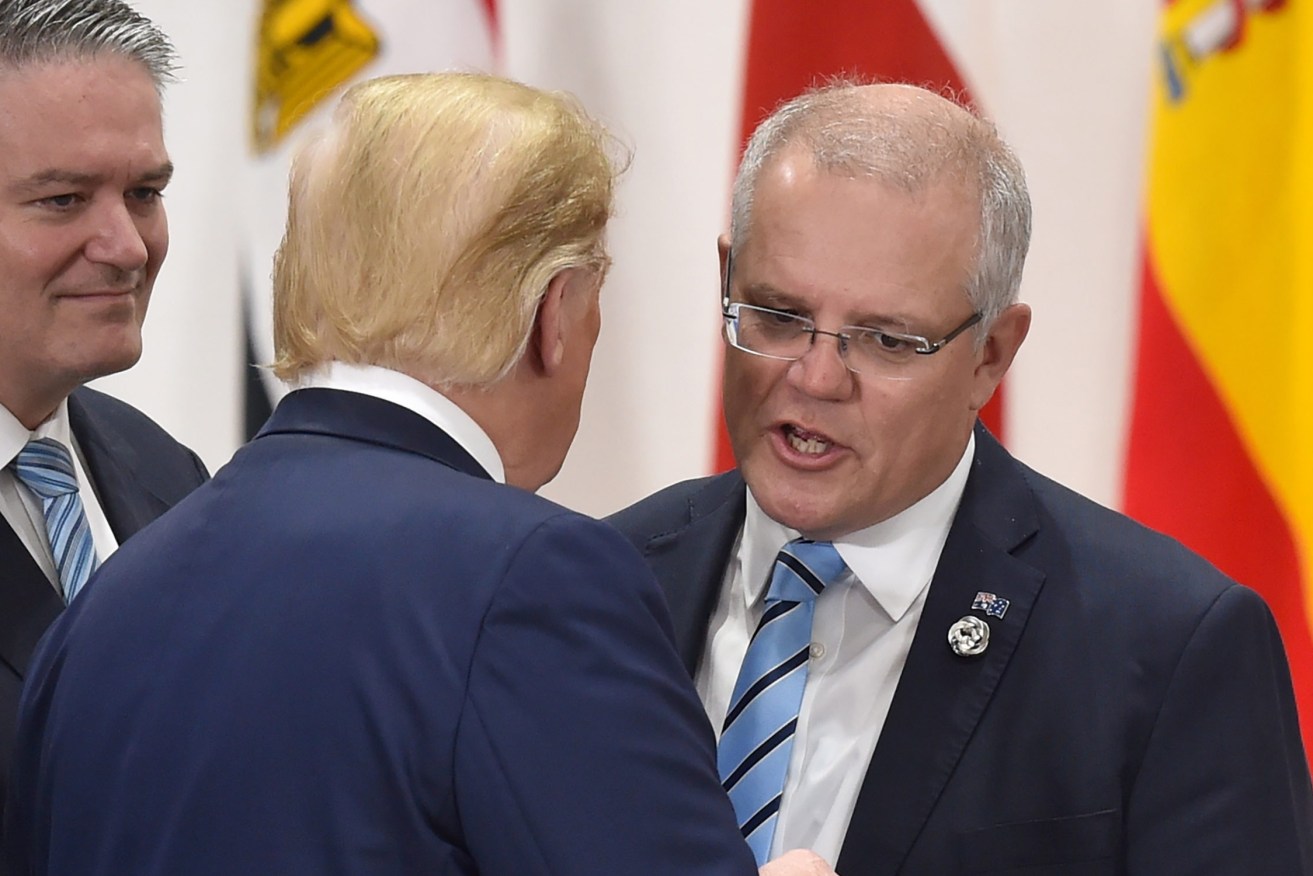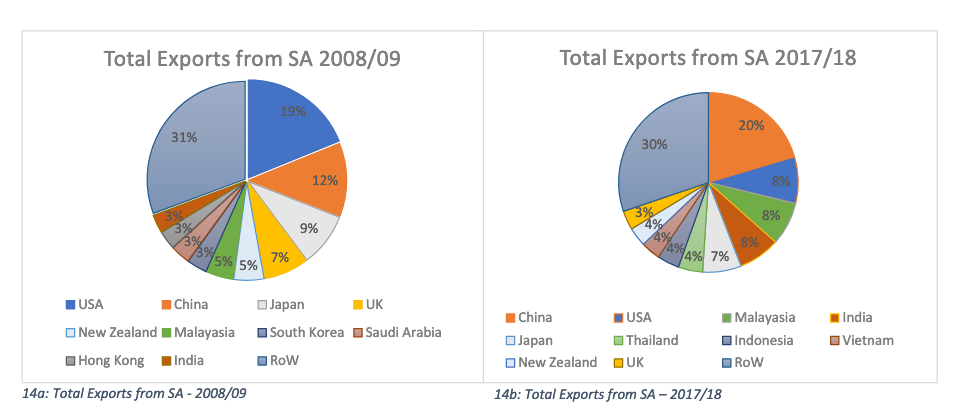USA versus China: South Australia’s export challenge
For South Australian exporters, China is now the main game but the US remains a key investor. How does a state like South Australia navigate the trade tensions between China and our closest strategic partner?


Prime Minister Scott Morrison with US President Donald Trump at the G20 summit in Japan last month. Photo: EPA/Kazuhiro Nogi
Two pie charts tell the story.
In his review of South Australia’s international and interstate “engagement bodies and functions”, former New Zealand economic development minister Steven Joyce notes the stark change in the state’s export focus over the past decade.

As Joyce notes, not only has China overtaken the US, there has been a watershed change in the top 10 export destinations for SA.
“Other changes in the composition of South Australia’s top export markets include the emergence of Malaysia and India ahead of Japan, while Thailand, Indonesia, and Vietnam have pushed the UK down and, South Korea and Saudi Arabia out of the Top 10 altogether,” he writes.
And yet, the United States remains hugely important – strategically, culturally and economically – and with a lot of potential for export growth. It’s one of the markets where the Marshall Government will re-establish a trade office for South Australia in the coming months.
The challenge for SA – as it is for the nation as a whole – is to navigate two key partners who are increasingly at loggerheads and who require very different engagement strategies.
Anthony Penney, Business SA’s executive director, industry and government engagement, says that while the United States is clearly closer to Australia than China both strategically and culturally, the US market is largely “transactional”, while exports to China are best facilitated via relationship building.
The tension inherent between our closest strategic ally and our biggest economic partner was on display in Adelaide last week, at a lunch hosted by AmCham – the American Chamber of Commerce in Australia.
The Melbourne-based US Consul General, Michael Kleine, told the gathering that the political relationship between Australia and the US was strong.
“We’re in sync at the highest levels,” he said, referencing President Donald Trump’s recent rare invitation for Prime Minister Scott Morrison to attend a state dinner in Washington.
He said that while Australia’s biggest trading partner was China, a better marker of an economic relationship was investment – noting that the “$1.7 trillion” investment exchange between the countries indicated a powerful relationship of trust.
Kleine also painted a rosy picture of the potential upside in US trade with South Australia, based on the location of the Australian Space Agency in Adelaide, which was “going to be a fundamentally transformative moment in this state”.
The Acting CEO of the Department for Trade, Tourism and Investment, Megan Antcliff, also looked beyond the export numbers.
She told the event that the US was the highest source of direct investment in South Australia by capital expenditure.
“There is close to $6 billion worth of US capital investment in South Australia since 2003, and over that same period reciprocal investment in the US market by South Australia companies of about $3.5 billion,” she said.
However, the value of the relationship to South Australia was challenged by former federal Labor minister Chris Schacht during question time.
Schacht, who introduced himself as an investor in South Australian wine, noted recent Wine Australia export statistics which showed that while shipments to the US had bounced to more than $400 million, the China market was worth $1.2 billion, with the majority of those exports coming from SA wineries.
He said tensions between China and the US – and the Australian Government’s position – threatened that crucial industry in SA.
“The relationship that we now find ourselves in – the triangle (of) America, China Australia – is extremely difficult and risky,” he said. “I found it very strange that the Prime Minister of Australia recently said ‘America is our best friend; China is our best customer’.
“I can assure you my feedback from China… was privately outraged.”
He said Australia would “shoot itself in the foot” with China if it was seen to be always following President Trump’s lead on political and strategic matters.
Penney offered a less febrile view of these challenges, telling InDaily that many South Australian exporters to China were unaffected by the bigger tensions in Sino-American relations.
“It’s businesses selling to other businesses,” he said. “For the most part, they just get on with it. While you may have political clouds on the horizon, they are still doing deals.”
However, he warned that a trade war that started to build tariff walls would affect the capacity of South Australian exporters to do business.
Hopes of avoiding out-and-out trade conflict are on the agenda this week, with US and Chinese negotiators meeting in Shanghai this week for their first talks since a G20 trade truce last month.
Penney pointed out that despite the political warmth in our relationship with the United States and tensions in intergovernmental relations with China, the reality for exporters is very different.
The US, he says, is a very “transactional kind of market, while China is more relationship-based”.
“If you build up that human connection in China, it puts you in good stead,” he said.
By contrast, the US markets were more focused on product itself – including cost.
This dynamic is one of the reasons why the previous State Government invested heavily in numerous trade missions to China. The Marshall Government is headlining its approach with new permanent trade offices in key markets, including China and the US.
The US office is due to open by the end of this year.
Of course, the State Government believes it can build exports to both key markets – China and the US – and Steven Joyce’s report argues there are different opportunities in both.
China has become a key South Australian market for education and related tourism. The US has upside in technology-based industries. Both want our food, wine and minerals.
Penney supports the trade office strategy and, while sceptical about “mega” trade missions, believes that industry-focused missions led by government can be useful.
The strategy is clearly crucial to the state’s prospects over the coming years and the State Government will need to find a way to keep both major partners engaged, even if outright trade war breaks out.
The US trade office, Antcliff says, will make a big effort to help South Australian companies make the most of the Australia-United States Free Trade Agreement which was years in the making.
In its June economic briefing, the South Australian Centre for Economic Studies said it expected South Australian exports to bounce back in 2019-20 after a poor agricultural season damaged our performance last year.
However, it warns “there are downside risks for the demand for South Australia’s overseas exports arising from the ongoing trade tensions between the US and China”.
Minister for Trade, Tourism and Investment, David Ridgway, did not take up InDaily’s offer to comment on the challenges we face in the tensions between these two key trade partners, but he did address how the Government plans to boost exports to the US.
“South Australian exports have seen some challenges in recent times compared to the rest of the nation and that is why the Marshall Liberal government is committed to finding new opportunities for our local exporters,” he said.
“Before the end of the year we will not only be well progressed in establishing a South Australian trade office in the US, we will also be supporting SA businesses on two outbound trade missions into the US – the ‘International Astronautical Congress’ in Washington, and ‘Aussie Wine Month’ to be held in six cities across the country.
“South Australian wine is hugely popular in the US and as part of our business mission calendar, we will be targeting key US states to further grow our wine export market into the region.”
He said the state’s biggest exports to the US in 2017-18 were wine and various forms of meat, while the biggest imports were aircraft launching gears, motor vehicles and storage batteries.
“Technologies being developed in South Australia in the defence and space industries will also provide great export opportunities into the future,” he said.
Behind the scenes, the dip in exports in recent years have been linked to the Thomas Foods fire at its meat processing plant last year and the closure of Holden.
Overall, South Australia is playing catch-up with the rest of the country on exports.
But could the exposure of the nation and South Australia to international headwinds be dealt with by a longer-term strategy?
Andrew Hunter, who leads Port Adelaide Football Club’s China engagement, believes so.
He says there is a problem with Australia’s over-reliance on both major powers – primarily, the limitations this places on our strategic options.
“Currently, Australia is over-reliant on China for our economic security, and on the United States for our (national) security,” he said. “Currently, we lack the courage to adopt a more neutral and, dare I say, independent foreign policy settings, and the patience to deepen long-term trade relationships, in my opinion.”




